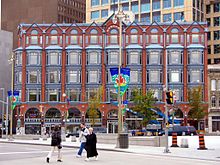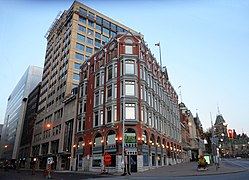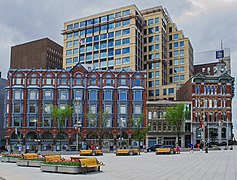
The National Capital Commission is the Crown corporation responsible for development, urban planning, and conservation in Canada's Capital Region, including administering most lands and buildings owned by the Government of Canada in the region.

The Office of the Prime Minister and Privy Council building, formerly known as the Langevin Block, is an office building facing Parliament Hill in Ottawa, Ontario, Canada. As the home of the Privy Council Office and Office of the Prime Minister, it is the working headquarters of the executive branch of the Canadian government.
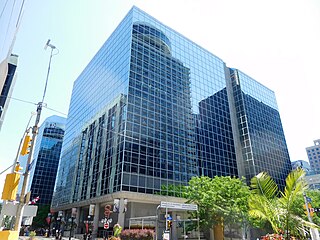
The C.D. Howe Building is an office tower in Ottawa, Ontario, Canada, that is the home of Innovation, Science and Economic Development Canada, the Office of the Auditor General and other smaller tenants. It was built by Olympia and York. The federal government sold the land to O&Y for a dollar and signed an agreement to lease the final building for a set rate until 2012. The eleven-story building was opened in 1978.

Sparks Street is a pedestrian mall in Ottawa, Ontario, Canada. It was a main street in Ottawa that was converted into an outdoor pedestrian street in 1967, making it the earliest such street or mall in Canada.

The National Capital Region, also referred to as Canada's Capital Region and Ottawa–Gatineau, is an official federal designation for the Canadian capital of Ottawa, Ontario, the neighbouring city of Gatineau, Quebec, and surrounding suburban and exurban communities. The term National Capital Region is frequently used to describe the Ottawa–Gatineau metropolitan area, although the official boundaries of the NCR do not correspond to the statistical metropolitan area.

The Senate of Canada Building is a government building and former railway station that serves as the temporary seat of the Senate of Canada. Located at 2 Rideau Street in downtown Ottawa, it was known as Ottawa Union Station and served as the city's central railway station from 1912 until 1966. From 1966 to 2018, it was operated by the Government of Canada as the Government Conference Centre. The building currently includes a temporary Senate chamber, as well as some Senate offices and committee rooms.

The current Ottawa City Hall is the city hall of Ottawa, Ontario, Canada. The downtown complex consists of two connected buildings: a modern wing located on Laurier Avenue and a 19th-century heritage wing located on Elgin Street. Although City Hall has frontage on two major streets, the main entrance is on Laurier Avenue, and the municipal address is 110 Laurier Avenue West.

Downtown Ottawa is the central area of Ottawa, Ontario, Canada. It is sometimes referred to as the Central Business District and contains Ottawa's financial district. It is bordered by the Ottawa River to the north, the Rideau Canal to the east, Gloucester Street to the south and Bronson Avenue to the west. This area and the residential neighbourhood to the south are also known locally as 'Centretown'. The total population of the area is 5,501.
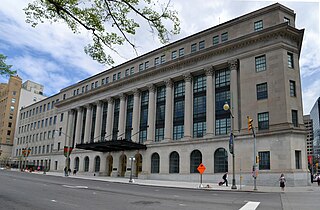
The Wellington Building is a Beaux-Arts architecture office building in Ottawa, Ontario, Canada. It was built between 1924 and 1927 as Canadian headquarters of the Metropolitan Life Insurance Company. The original structure was designed by D. Everett Waid; in 1959, the more restrained classical east wing of the building was added.

Confederation Park(French: Parc de la Confédération) is a public park and National Historic Site of Canada, located in the downtown core of Ottawa, Ontario, Canada. It is bordered on the south by Laurier Avenue and Ottawa City Hall; on the east by the Rideau Canal and National Defence Headquarters; on the north by the Mackenzie King Bridge, the Rideau Centre and the National Arts Centre; and to the west by Elgin Street and the Lord Elgin Hotel.

The Sir John A. Macdonald Building is a former bank building in Ottawa now owned by the federal government of Canada. It is located at 144 Wellington Street, at the corner of O'Connor Street, with a third frontage on Sparks Street, just in front of West Block of Parliament. Its façade indicates its former heritage as a Bank of Montreal branch location.

The architecture of Ottawa is most marked by the city's role as the national capital of Canada. This gives the city a number of monumental structures designed to represent the federal government and the nation. It also means that as a city dominated by government bureaucrats, much of its architecture tends to be formalistic and functional. However, the city is also marked by Romantic and Picturesque styles of architecture such as the Parliament Building's Gothic Revival architecture.
The Plaza Bridge in Ottawa, Ontario, Canada, is an automotive and pedestrian bridge that crosses the Rideau Canal just south of the Ottawa locks. It joins Wellington Street and Elgin Street in the Downtown core to the west with Rideau Street to the east. The Chateau Laurier abuts the bridge at the east end, while Parliament Hill is just beyond the west end. It is the northernmost bridge over the canal, just north of the Mackenzie King Bridge.
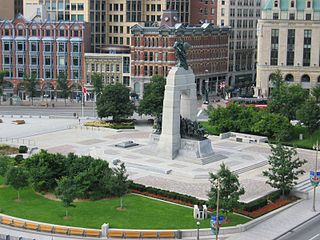
Confederation Square is an urban square in Ottawa, Ontario, Canada, and is considered the second most important ceremonial centre in Canada's capital city, after Parliament Hill. Roughly triangular in area, with Canada's National War Memorial at its centre and the Valiants Memorial at its periphery, the square is bounded by Wellington Street to the north and branches of Elgin Street to the east and west.
Ottawa Electric Railway Company was a streetcar public transit system in the city of Ottawa, Canada, part of the electric railway streetcars that operated between 1891 and 1959. Ottawa once had tracks through downtown on Rideau Street, Sparks Street and others, and extended outside of the downtown core to provide services that helped form communities such as Westboro, Old Ottawa South and The Glebe. Prior to this, starting in 1866, public transportation was provided by Ottawa City Passenger Railway Company, a horse-drawn tram service. The O.E.R. was taken over by the Ottawa Transportation Commission in 1948, which was itself succeeded by OC Transpo in 1973.

Occupy Ottawa was a mostly peaceful, leaderless, grassroots and democratic protest movement that began on Confederation Park in Ottawa, Ontario, on October 15, 2011. The movement's slogan "Home of the global revolution in Ottawa" refers to its inspiration by, and association with, the Arab Spring, Occupy Wall Street and the global Occupy Movement, which protests growing economic inequality, corporate greed, and the influence of corporations and lobbyists on electoral politics and government. Occupy Ottawa seeks global economic, social, political and environmental justice.

Bell Block is a building in Ottawa, Ontario, Canada. It is located on 40 Elgin Street between the Central Chambers and Scottish Ontario Chambers. It was built in 1867 to a design by William Hodgson (1827–1904). Designated as a heritage property under Part IV of the Ontario Heritage Act, it was honoured with an "Award of Excellence" from the City of Ottawa.

The Scottish Ontario Chambers is a building in Ottawa at the corner of Sparks Street and Elgin Street that was built in 1883. It was designed by William Hodgson. It is designated as a heritage property under Part IV of the Ontario Heritage Act.

Queen Street is an east–west arterial road located in Downtown Ottawa, Ontario, Canada. The street is two-way with one to two lanes going in each direction. The Confederation Line runs underneath Queen Street.

Peterborough City Hall is the seat of the municipal government of Peterborough, Ontario, Canada. It is a 2+1⁄2-storey building, located at 500 George Street North, across the street from Confederation Park, the Drill Hall and Armouries and Peterborough Collegiate. The complex consists of two buildings: the City Hall built in 1951 and the former Carnegie Library built in 1911.
